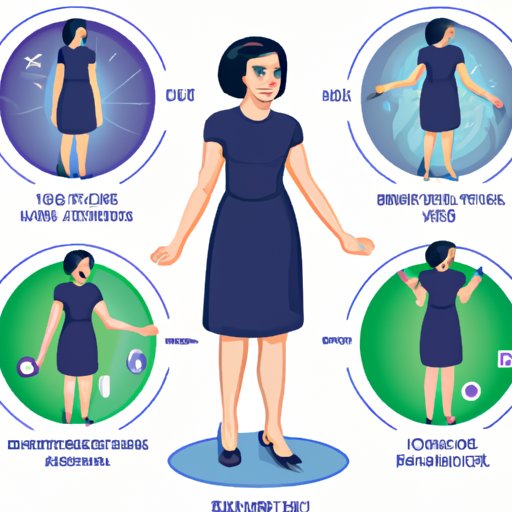I. Introduction
Do you ever feel like your heart is pounding out of your chest, you can’t breathe, and you’re convinced that something terrible is about to happen? You might be experiencing a panic attack. Panic attacks can be scary and debilitating, but the good news is that there are techniques you can use to calm down during one.
In this article, we’ll go through six steps to help you calm down from a panic attack. By practicing these techniques, you’ll be better equipped to manage your symptoms and feel more in control during a panic attack.
II. Step 1: Recognize the Panic Attack
The first step in calming down during a panic attack is recognizing that it’s happening. Common symptoms of a panic attack include:
- Rapid heartbeat
- Shortness of breath
- Sweating
- Trembling
- Feeling dizzy or lightheaded
- Feeling like you’re choking or suffocating
- Chest pain or discomfort
- Nausea or stomach pain
- Feeling like things around you are unreal or detached
- Fear of losing control, dying, or going crazy
If you’re experiencing these symptoms, it’s important to recognize them as signs of a panic attack so you can take action to calm down.
III. Step 2: Find a Safe Space
The next step is finding a safe space where you feel comfortable. This might be a quiet room in your home, a park bench outside, or even your car. The important thing is to find a place where you feel safe and won’t be disturbed.
If you’re in a public place and can’t leave, try to find a quiet corner where you can sit down and breathe deeply. You can also try covering your head with a jacket or scarf to block out some of the visual stimulus around you.
IV. Step 3: Practice Deep Breathing
Deep breathing is a powerful technique for calming down the body during a panic attack. It works by slowing down your breathing and increasing the amount of oxygen in your bloodstream, which helps to reduce the physical symptoms of anxiety.
To practice deep breathing, try the following technique:
- Sit down or stand up straight, whichever feels most comfortable.
- Place one hand on your chest and the other on your stomach.
- Inhale through your nose for a count of four, feeling your stomach expand with air.
- Hold your breath for a count of two.
- Exhale through your mouth for a count of six, feeling your stomach contract as you expel the air.
- Repeat this process for several minutes, until you feel your body start to relax.
V. Step 4: Use Positive Affirmations
Positive affirmations are a powerful tool for shifting negative thinking patterns and promoting a sense of calm during a panic attack. By repeating positive statements to yourself, you can shift your focus from negative thoughts to positive ones, which can help to reduce anxiety and stress.
Some examples of positive affirmations that you can use during a panic attack include:
- “I am safe, and everything is going to be okay.”
- “I am strong, and I can get through this.”
- “My body knows how to calm down, and I trust it.”
- “I am in control of my thoughts and emotions.”
- “I am loved and supported.”

VI. Step 5: Visualize a Calm Place
Visualization is a powerful tool for calming down the mind and body during a panic attack. By picturing a peaceful and calming scene in your mind, you can help shift your focus away from the physical sensations of anxiety and onto a more positive experience.
To use visualization during a panic attack, try the following technique:
- Close your eyes and take several deep breaths.
- Picture yourself in a calm and peaceful environment. This could be a beach, a forest, a meadow, or any place that makes you feel relaxed.
- Imagine yourself surrounded by the sights, sounds, and sensations of this peaceful place. Picture the sun on your skin, the sound of the waves, or the smell of flowers.
- Visualize yourself feeling calm and relaxed in this environment, free from anxiety and stress.
- Stay in this visualization for several minutes, or as long as it takes to feel a sense of calm.
VII. Step 6: Use Progressive Muscle Relaxation
Progressive muscle relaxation is a technique for releasing physical tension in the body. By tensing and then releasing different muscle groups, you can help reduce the physical symptoms of anxiety and promote a sense of relaxation.
To practice progressive muscle relaxation, try the following technique:
- Sit down or lie down in a comfortable position.
- Starting with your toes, tense the muscles in your feet and hold for a count of five.
- Release the tension and relax for a count of ten.
- Move up to your calves and repeat the process of tensing and then releasing.
- Continue moving up your body, tensing and relaxing each muscle group in turn, including your thighs, buttocks, stomach, chest, arms, hands, neck, and face.
- Repeat this process as many times as necessary to feel relaxed.
VIII. Conclusion
Calm down from a panic attack can feel overwhelming, but by using these techniques, you can learn to manage your symptoms and promote a sense of calm and relaxation. Remember that calming down during a panic attack takes practice and patience, so be gentle with yourself as you learn these techniques.
Try practicing these steps before you experience a panic attack, so you’re better prepared to manage your symptoms if and when they occur. By recognizing the symptoms of a panic attack, finding a safe space, practicing deep breathing, using positive affirmations, visualizing a calm place, and using progressive muscle relaxation, you can calm down from a panic attack and feel more in control of your anxiety.
